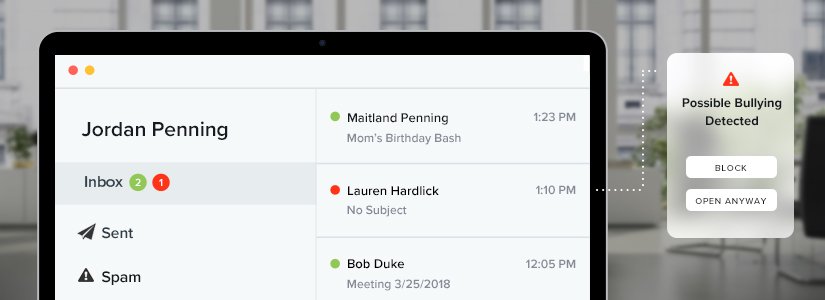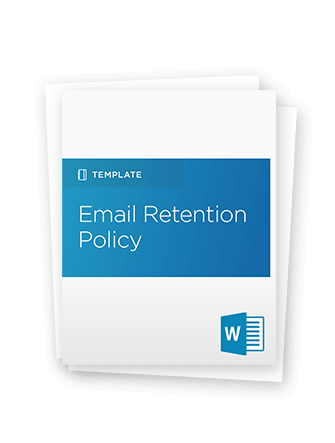Email Abuse at Work: How to Prevent Misuse of Email in the Workplace

Email abuse in the workplace exists in various forms, ranging from co-workers simply exchanging emails with inappropriate language, to more serious situations involving sexual harassment and bullying. And chances are, in today’s world so dominated by email, your organization is not immune to the many forms of email abuse.
Fortunately, there are steps you can take to ensure that email abuse at work stops, and to guarantee that you are legally covered when dealing with the fallout of inappropriate emails in the workplace.
HR Challenges: Bullying & Abuse — They’re All Related to Email
When the subject of bullying comes up, it is usually thought of as a behavior that takes place at school, as in grades K-12 (and perhaps to a lesser extent in college). But bullying also exists in the workplace — left unchecked it can adversely affect employee morale and productivity, not to mention the company’s financial bottom line.
What is Workplace Bullying?
The Workplace Bullying Institute defines workplace bullying as “repeated, health-harming mistreatment of one or more persons (the targets) by one or more perpetrators.” That includes the acts of harassing, offending and socially excluding someone, or negatively affecting someone’s work tasks, often committed via personal attacks, social ostracism and a multitude of other hostile interactions.
Workplace bullying is prompted “by perpetrators’ need to control the targeted individual(s), or initiated by bullies who choose their targets, timing, location and methods.” Such workplace bullying – the nonverbal kind – can occur by email or posts on Web-based social media such as Facebook or Twitter. This is specifically referred to as cyberbullying.
Cyber-bullying can arise in many instances, and does not occur only between a subordinate and their superior. In fact, many cases of emotional abuse in the workplace also take place between and among co-workers who are colleagues and equals. This implies that differences in position and rank are not the only “power” factors at play, and can also be attributed to a social power imbalance. Furthermore, the FCC lists unwanted email communications as one form of workplace harassment.
Examples of workplace bullying include:
- Spreading malicious rumors, gossip or innuendo
- Employing intimidation techniques
- Threatening, or perpetrating, physical abuse
- Deliberately excluding or isolating someone socially
- Undermining or intentionally impeding a person’s work
- Removing areas of responsibilities without cause
- Constantly changing work guidelines
- Designing impossible deadlines to incite individual failure
How to Eliminate Workplace Bullying and Other Types of Email Abuse
There are several useful steps your organization can take to raise awareness of, or eliminate, workplace abuse or bullying that takes place over email or social media.
First and foremost, employers need to have concise and comprehensive policies in place that provide concrete definition as to acceptable communications practices via email and social media. A well-communicated company email policy will instill in employees the instinct to think twice before clicking the “send” button, and decrease any potential liability for employers when dealing with potential litigation or legal trouble.
A thorough email policy should contain the following elements:
- A statement that the employer’s email system is employer property, to be used for the purposes of furthering employer business. For almost two decades, experts in the subject matter have defined emails made on company time on company equipment by company employees as company property. Your policy should emphasize this, as well as state whether personal emails are permitted and define any limitations on personal use of the system.
- An explanation of the rules governing the use of the email system. For example, employees should be informed that email use should comply with all applicable laws and regulations, and that the system should not be used to:
- Transmit or receive confidential or sensitive information
- Transmit or receive discriminatory, harassing, sexually oriented, offensive or other illegal or improper messages
- Download unauthorized software onto the employer system
- If the employer intends to monitor employee email, the policy should state this, as well as the business reasons for doing so and the circumstances under which monitoring will take place. The policy should include a statement that the employee has no expectation to privacy regarding any emails sent, received or stored at the workplace.
Furthermore, organizations should incorporate an appropriate list of potential penalties for violations such as email abuse at work or a general misuse of email in the workplace. These rules will help to reiterate the emphasis an organization puts on proper communications.
Penalties organizations have sanctioned vary; sometimes, a soft or written warning is all that is needed to address an issue. More serious offenses can warrant penalties such as probation, suspension, demotion, or even termination. If strict measures aren’t taken to deal with email abuse, it can be perceived that your business condones the type behavior that was exhibited.
There is precedence for terminating an employee due to misuse of email in the workplace. A study of almost 600 U.S.-based companies done by the American Management Association and the ePolicy Institute found that more than a quarter of employers had fired individuals for misuse of email in the workplace. Over 50% of those queried had fired people for a violation of organizational communications policies; of that, 62% had been fired for inappropriate or offensive language found within their communications.
Learn to Identify Email Abuse at Work
One of the most progressive steps an organization can take regarding email abuse is to simply increase the awareness of its existence in the workplace.
Abusive behavior creates a toxic work environment, one in which many workers unfortunately feel uncomfortable reporting harassment to their bosses or HR managers. Employers should be able to guarantee that issues will be identified quickly and dealt with thoroughly.
There are a handful of things to look for when identifying workplace bullying:
- Notice palpable attitude changes
- If an employee exhibits a discernible shift in demeanor at work, it is worth reaching out to see if they are experiencing any issues.
- Diligently monitor communications
- Bullying takes place between equals, but also between people in different power structures throughout an organization. Be sure to examine all levels of the company for any signs of inappropriate email use in the workplace.
- Have Zero Tolerance
- If a complaint of abuse is made against management, it must be taken just as seriously as if it were an interaction between employees. Favoritism drastically undermines the policies an organization has in place.
How to Counteract Workplace Bullying Using Archiving Technology
Companies can help to ensure their employees are not misusing their emails by using archiving systems, which can be set up to monitor interactions across email and multiple platforms of social media. These systems are designed to log every communication in and out of your organization, which can guarantee that any interaction that violates your company policy is stored and maintained permanently.
Archiving systems act as a sort of fail-safe measure for your organization; if abuse is reported in any case, the message in question can be recalled and used as testimonial evidence without any hesitation.
For example, say an employee lodges a complaint against a co-worker, alleging bullying or abuse in the form of intimidating and threatening email. In certain cases, the accused may try to alter or delete the communications in question. Using an archiving system eliminates the possibility that the communication will be tampered with, as any communication inbound or outbound is automatically stored and kept for as long as company policy dictates.
Additional Resources:
Workplace bullying by email or social media can and should be addressed — but how you address it depends on the circumstances, whether mild or severe, as well as who is involved.
There are a few tangible items an organization can try in attempts to help identify, monitor or eliminate abuse via email in the workplace. In addition to message archiving products, some companies offer Advanced Reporting technologies, which can provide needed insight into the relationships that employees are fostering. Additionally, depending on the source of the abuse, filters can be individually implemented within the inbox as a means to prevent malicious emails from reaching their intended target.
The most effective way to prevent or eliminate bullying in the workplace is to increase the awareness of it happening. This can be done by providing training for all employees on the extent of bullying and its effects. Companies can offer online courses designed to educate employees on the legal ramifications of bullying, which vary state-by-state, but are being addressed with more severity each year. Similarly, providing a safe place for employees to voice their concerns and complaints helps to guarantee that a culture of silence is not cultivated within your workplace.
There are a number of other, more personal ways, to increase the awareness of these situations in and around your workplace. Some of the more helpful articles include ways to inform your co-workers about their emails, ways to reform your own email, how to deal with bullies at work or how to further increase your awareness of the situation.
If you are having trouble with cyberbullying at work and are afraid to speak out, the government has websites dedicated to helping you identify the problem, as well as what to do to find help if you are seeking it.
Check out other information regarding the relationship between HR challenges and email archiving, or contact us for information on how our Email Archiving products can help create a communal work environment that ensures everyone’s best productivity.

